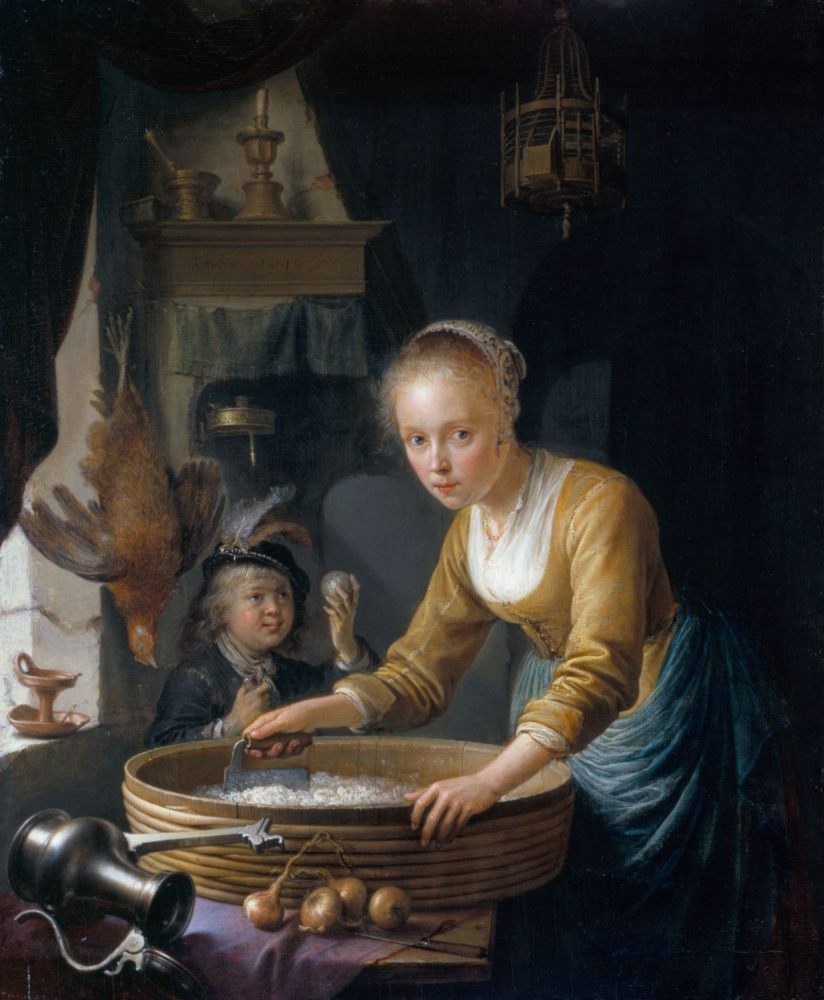log in
Enter site
Login to use Arthive functionality to the maximum
The girl chopping onions
Gerrit (Gerard) Dow • Painting, 1646, 20.9×16.8 cm
Description of the artwork «The girl chopping onions»
The Girl Chopping Onions is one of Gerrit Dou’s stocks in trade along with his Young Mother. A number of parallels can be drawn between these two works. Firstly, both represent magnificent examples of the Leiden school of fijnschilders (“fine artists”) with their meticulous execution of the smallest detail and a smooth, polished surface. Also, in both paintings, the artist alludes to the personal life of his female subjects. However, instead of the virtuous married Young Mother, the goodwife in the well-furnished upper chambers of the then Dutch elite, here the viewer is taken into the world of carnal intrigues of the “lower” kitchen world.
At first glance, there is nothing erotic about the Girl Chopping Onions. Just as in the Young Mother panel, the artist shows a blonde young woman who is caught off-guard at work. The light from the window on the left dimly exposes a dead partridge hanging upside down, an empty birdcage and a jug lying on its side.
Cookmaids’ affairs were one of Dou’s favourite themes. Here he could not only demonstrate his brilliant talent as a master of still life, but also fill the space with numerous, sometimes ambiguous visual hints. Lustful cooks were often heroines of comedy literature in 17th century Holland, and artists emphasized their assets with the symbols taken from books, proverbs and sayings.
In this case, the empty birdcage can be understood as a symbol of lost virginity. Additional allegories are the partridge (the Dutch word vogel, bird, in slang also means “copulation”, and vogelen, to catch birds, is a euphemism for “having sex”) and onions, which were considered an aphrodisiac then. Many of the objects in the picture, such as the candle, the mortar and pestle, and the jug, have explicit sexual connotations. The boy holding out an onion to the woman could be a good Cupid if he were not dressed and wingless.
However, all these disparate aspects can be combined with a different, broader meaning: the boy represents innocence here, while the girl, experience. However, in France in the 18th century, the story in the painting of Dou was interpreted unambiguously. The engraver Pierre Louis de Surugue provided his etching with the following verse: “‘I am willing to believe that you are / Knowledgeable in the art of preparing stews / But I feel even more appetite for you / Than the stew that you are making”.
Written by Vlad Maslov
At first glance, there is nothing erotic about the Girl Chopping Onions. Just as in the Young Mother panel, the artist shows a blonde young woman who is caught off-guard at work. The light from the window on the left dimly exposes a dead partridge hanging upside down, an empty birdcage and a jug lying on its side.
Cookmaids’ affairs were one of Dou’s favourite themes. Here he could not only demonstrate his brilliant talent as a master of still life, but also fill the space with numerous, sometimes ambiguous visual hints. Lustful cooks were often heroines of comedy literature in 17th century Holland, and artists emphasized their assets with the symbols taken from books, proverbs and sayings.
In this case, the empty birdcage can be understood as a symbol of lost virginity. Additional allegories are the partridge (the Dutch word vogel, bird, in slang also means “copulation”, and vogelen, to catch birds, is a euphemism for “having sex”) and onions, which were considered an aphrodisiac then. Many of the objects in the picture, such as the candle, the mortar and pestle, and the jug, have explicit sexual connotations. The boy holding out an onion to the woman could be a good Cupid if he were not dressed and wingless.
However, all these disparate aspects can be combined with a different, broader meaning: the boy represents innocence here, while the girl, experience. However, in France in the 18th century, the story in the painting of Dou was interpreted unambiguously. The engraver Pierre Louis de Surugue provided his etching with the following verse: “‘I am willing to believe that you are / Knowledgeable in the art of preparing stews / But I feel even more appetite for you / Than the stew that you are making”.
Written by Vlad Maslov


